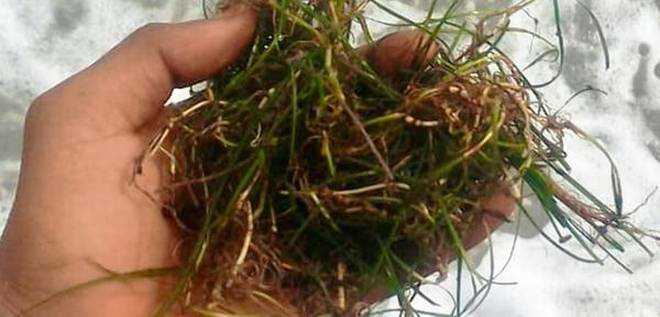Description

Copyright infringement is not intended
Context: The Government of India Programme on Seagrasses.
About Seagrasses:
- These are flowering plants which are found in our sea beds and ocean floors. It is one of the groups of marine angiosperms. They often lives entirely submerged.
- With tiny flowers and strap-like or oval leaves, they require sunlight for photosynthesis.
- Though seagrasses inhabit all types of substratas (layers) from mud to rock, the lush green seagrass beds are found extensively in muddy and sandy substratas.
- Distribution: The major seagrass beds exist along our coastline of Gulf of Mannar and Palk Bay regions on the east coast, Gulf of Kachchh region on the west coast, the lagoons of islands in Lakshadweep in the Arabian Sea and Andaman and Nicobar Islands in the Bay of Bengal.
- Important Species: Some of the important seagrasses are Sea Cow Grass (Cymodocea serrulata), Thready Seagrass (Cymodocea rotundata), Needle Seagrass (Syringodium isoetifolium), Flat-tipped Seagrass (Halodule uninervis), Spoon Seagrass (Halophila ovalis) and Ribbon Grass (Enhalus acoroides). These were once abundant in the Gulf of Mannar region but are now threatened.
- Reproduction: Seagrasses reproduce through both sexual and asexual methods.
- The pollen from the flower of the male plant is transferred to the ovary of the female flower through the sexual reproduction method. This is known as submarine pollination. Most species undergo this process and complete their life cycle underwater.
- Seagrasses can also reproduce asexually by branching off at their rhizomes (modified subterranean plant stem that sends out roots and shoots from its nodes). Because of this character, they can recover after being cut by grazers like dugongs or disturbed by storms.
- Based on field surveys and satellite data, the National Centre for Sustainable Coastal Management has estimated the total extent of seagrass ecosystem in India to be 516.59 km2.
- Seagrass ecosystems play an important role in sequestering carbon, nurture fish communities and support marine mammals such as sea cows or dugongs.
- Usage:
- Traditional medicine: used for a variety of therapeutic purposes such as wound-healing, fever, stomach aches, muscle pains and skin diseases.
- Biomedical applications such as anti-cancer, anti-diabetic, anti-inflammatory, anti-fungal, anti-bacterial and anti-viral activities.
Seagrasses - ‘Ecosystem Engineers’
- Seagrasses are known for providing many ecosystem services. They are considered to be ‘Ecosystem Engineers’.
- Seagrasses help maintain water quality. They trap fine sediments and suspended particles in the water column and increase water clarity.
- They filter nutrients released from land-based industries before they reach sensitive habitats like coral reefs.
- Ocean bottoms without seagrasses are prone to intense wave action from currents and storms. The extensive vertical and horizontal root systems of seagrasses stabilise the sea bottom similar to land grasses that prevent soil erosion.
- Seagrass habitats protect juvenile and small adult fish from large predators. Marine animals that live in soft sea bottom sediments also take shelter in seagrass meadows.
- Seagrasses protect worms, crabs, starfishes, sea cucumbers, sea urchins, etc, from strong currents. Seagrass leaves support seaweeds by providing anchoring facilities. Seahorses and lizardfish are found living in seagrass meadows almost throughout the year.
- Seagrasses provide food as well as habitat for fishes, octopuses, shrimp, blue crabs, oysters, sponges, sea urchins, clams, etc. They are called ‘the lungs of the sea’ as they release oxygen into the water through photosynthesis.
- Some endangered marine organisms like dugong, green turtle, etc, graze directly on seagrass leaves. Many other microorganisms take the nutrients indirectly from seagrasses.
- Bottle-nosed dolphins feed on the organisms that live in seagrass areas. Detritus (natural waste) of decomposed dead seagrass supplies food for worms, sea cucumbers, crabs, anemones and ascidians.
- Seagrass meadows provide ideal nursery sites for important commercial marine life like squids and cuttlefish in Tamil Nadu.
- Seagrasses were used as fertiliser for sandy soil. The grasses had been used for bandages also.
- Seagrasses absorb 83 million tonnes of carbon from the atmosphere annually. Seagrasses can capture carbon from the atmosphere up to 35 times faster than tropical rainforests.
Why there is need to protect sea grasses?
- Seagrass beds are facing decline all over the world at the rate of 2-5 per cent annually. Some 30,000 square kilometres of seagrass has been lost during recent decades at a global level.
- Seagrasses face natural disturbances like grazing, storms, ice-scouring and desiccation. Human disturbances like eutrophication, mechanical destruction of habitat, overfishing and release of nutrients play havoc on seagrasses.
- Siltation, trawling, coastal engineering construction, pollution, etc, are causing deterioration of seagrasses. Sea Cow (Dugong) and Green Turtle that depend on seagrass for their food also face a severe threat.
- Protection and restoration of seagrasses can play a significant role in mitigating climate change.
- If seagrass habitats are lost, the marine organisms that depend on them for their survival may also face extinction, resulting in the loss of marine ecosystem productivity.
- There is an urgent need to take earnest measures to conserve seagrasses and their habitats.
- The International Union for the Conservation of Nature should intervene immediately and study the status of the different seagrass species before they become extinct.
Measure taken for seagrass conservation:
- Seagrasses have been studied for over two decades with the financial support of the Ministry of Environment, Forest and Climate Change and the State/UT Governments.
- Academic and research institutions have been actively involved in seagrass mapping, species diversity and its transplantation.
- Government has initiated a project across the States of Andhra Pradesh, Maharashtra, and Odisha on enhancing climate resilience of India’s coastal communities, which includes a grant of US$ 43.419 million by Global Climate Fund (GCF) covering 24 ecosystems such as mangroves and seagrasses.
https://www.pib.gov.in/PressReleasePage.aspx?PRID=1810578











